Bye Paul Tauterouff
Note: Prior knowledge of the five Minor Pentatonic box patterns and the 7 modal shapes is helpful for understanding this lesson, but not absolutely necessary.
Objective: To help guitarists already familiar with the pentatonic scale to learn and utilize the modes in their lead guitar playing.
You can receive a free companion pentatonic scale lesson by visiting free guitar lessons from Paul Tauterouff.
As a guitarist, I am primarily self-taught and didn’t have any formal music theory training in the early stages of my playing. The first scales that I learned were the five positions or box patterns of the minor pentatonic scale. I wrote the diagrams out by hand, and would play (and draw) them constantly.
When I was first exposed to the seven modes of the major scale, I did the same thing; sketched the fretboard diagrams, studied how the shapes fit together, etc. Even after I had the modal shapes memorized, I was still having a difficult time actually applying them to my lead playing. Seven shapes just seemed like too many after becoming so accustomed to the five box patterns of the pentatonic scale.
Then I came up with an idea: What if I divided the modes of the major scale up into 5 scale chunks, based on the five Minor Pentatonic box patterns that I was already comfortable with? This way I would only have to add a couple of new notes to each of the 5 pentatonic boxes! For lack of a better name, I’ve decided to call this the Pentamodal Idea.
To demonstrate, let’s work out an example for a scale which is commonly used in rock guitar lead playing - the 6 th mode of the Major Scale, Aeolian mode (a.k.a. the Natural Minor scale). The following examples are in the key of A minor.
Here is our 1 st Pentamodal shape, Aeolian Mode:
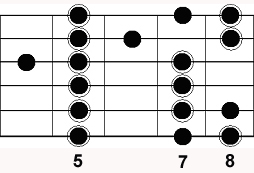
Aeolian Mode w/ A Minor Pentatonic box 1 notes circled
We will skip Locrian, the mode that would normally follow Aeolian, since its first note (B at the 7 th fret of the low E string) does not align with our A Minor Pentatonic scale box patterns.
This brings us to Pentamodal Pattern #2, Ionian Mode:
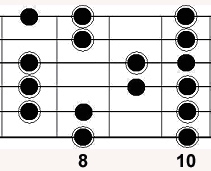
Ionian Mode w/ A Minor Pentatonic box 2 notes circled
Note : Keep in mind that even though we may have skipped over the Locrian Mode, its notes are still available for us to use in our soloing via patterns 1 and 2, we just aren’t thinking of it as its own individual shape or box pattern.
Continuing in order, Pattern #3 consists of the Dorianshape:
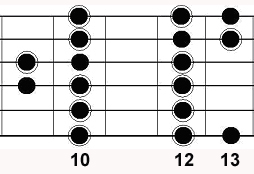
Dorian Mode w/ A Minor Pentatonic box 3 notes circled
Next is Pattern #4, which includes the Phrygian mode:
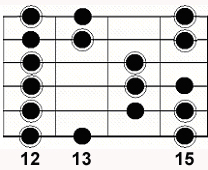
Phrygian Mode w/ A Minor Pentatonic box 4 notes circled
We will skip the mode that would normally follow Phrygian, (Lydian) because its first note does not align with the Minor Pentatonic scale box pattern in our A Aeolian-based example.
This brings us to our 5th and final pattern, using the Mixolydian mode:
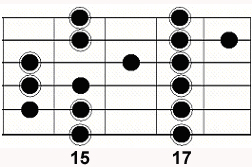
Mixolydian Mode w/ A Minor Pentatonic box 5 notes circled
Key Points:
- Remember, we’re still playing all of the notes of the seven modes, we’ve just chosen to break them up into 5 box patterns – like our minor pentatonic scales.
- The above patterns will also work for a C Ionian (Major) root, since it is the relative major of A Aeolian Mode.
- Depending on which mode we choose to be our #1 (root) or parent scale, different modes may be skipped over. For example, if A Dorian minor was our #1 scale, we would skip Phrygian (at B, the 7 th fret of the low E string) and Lydian would be our #2 shape, at the 8 th fret (the C note).
- This is a “quick-and-dirty” method for assimilating the modes into your playing. Once you become familiar with using these shapes, I highly recommend also working out and memorizing the three note-per-string patterns for the modes. Box patterns are great for breaking ideas into small, easily digestible pieces, but you don’t want to be limited by them either.
Once again, if you are not familiar with the pentatonic scale or want another angle on it, visit http://paultauterouff.com/freeguitarlesson.php to receive a free companion pentatonic lesson along with several other free bonus guitar lessons.
I hope this lesson has helped you to begin to implement modal sounds into your guitar playing - have fun!
About The Author:
Paul Tauterouff is a professional musician/ guitar teacher in New York.
For more information visit Paul’s website at Paul Tauterouff
©2009 Paul Tauterouff All Rights Reserved
